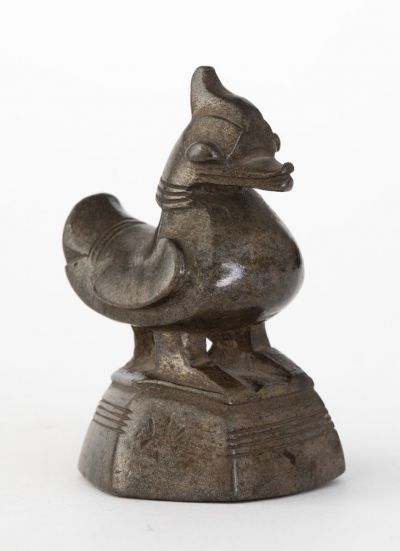
Opium weight
| Accession Nr.: | 2015.2.1 |
|---|---|
| Type: | bronze, lead, gold and silver; object for daily use; small bronze |
| Date of production: |
20th century
|
| Place of production: |
This small object in the shape of a bird and standing on a hexagonal pedestal has engraved decoration. With its eight companions they arrived to the Hopp Museum from the collection of Ödön Ráday and his wife.
These bronze weights, known in the literature and among collectors as 'opium weights', were certainly used in Burma from the 14th century to determine the value of opium, various precious metals, and precious stones. The largest weight was about 1600 grams, while the smallest was only two hundredth of that weigh. Over the centuries, the monarch who succeeded to the throne usually issued a new series of mythological or animal figures, with slightly varying preferences (frog, dog, bull, elephant...). However, the hintha/hamsa bird (ruddy shelduck, in India Brahmini duck) and the karaweik (Burmese crane / Sarus crane) retain popularity. Although opium weights have been replaced in use since British colonialism by simple iron plates (as weights) and by the introduction of money as currency, they have not lost their former appeal to collectors and tourists.
These bronze weights, known in the literature and among collectors as 'opium weights', were certainly used in Burma from the 14th century to determine the value of opium, various precious metals, and precious stones. The largest weight was about 1600 grams, while the smallest was only two hundredth of that weigh. Over the centuries, the monarch who succeeded to the throne usually issued a new series of mythological or animal figures, with slightly varying preferences (frog, dog, bull, elephant...). However, the hintha/hamsa bird (ruddy shelduck, in India Brahmini duck) and the karaweik (Burmese crane / Sarus crane) retain popularity. Although opium weights have been replaced in use since British colonialism by simple iron plates (as weights) and by the introduction of money as currency, they have not lost their former appeal to collectors and tourists.